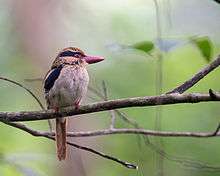Lilac kingfisher
The lilac kingfisher or Celebes flat-billed kingfisher (Cittura cyanotis) is a resident breeding bird in the lowlands of the Indonesia island of Sulawesi and the neighbouring Sangihe and Talaud Islands. It is the only member of the genus Cittura.
| Lilac kingfisher | |
|---|---|
 | |
| Scientific classification | |
| Kingdom: | Animalia |
| Phylum: | Chordata |
| Class: | Aves |
| Order: | Coraciiformes |
| Family: | Alcedinidae |
| Subfamily: | Halcyoninae |
| Genus: | Cittura Kaup, 1848 |
| Species: | C. cyanotis |
| Binomial name | |
| Cittura cyanotis (Temminck, 1824) | |
Taxonomy
The first formal description of the lilac kingfisher was by the Dutch zoologist Coenraad Jacob Temminck in 1824 under the binomial name Dacelo cyanotis.[2][3] The genus Cittura was introduced by the German naturalist Johann Jakob Kaup in 1848.[4] The genus name is from classical Greek kitta for "magpie" and oura for "tail". The specific epithet cyanotis is from classical Greek kuanos for "dark blue" and -ōtis" for "eared".[5]
There are two subspecies:[6]
- C. c. sanghirensis (Temminck, 1824) – Sangihe and Talaud Islands
- C. c. cyanotis Sharpe, 1868 – northern Sulawesi, Lembeh Island
Description
The lilac kingfisher is 28 cm (11 in) long. It has the typical kingfisher shape, with a short tail and long bill. The adult male of the nominate race, C. c. cyanotis, has a brown crown and back and rufous rump and tail. It has a blue eye mask, separated from the crown by a white line, and a pale lilac ruff of long stiffened ear covert feathers. The underparts are white and the wings are blue, separated by a white line from the brown back. The red bill is large and flattened. In flight, the underwings are white with a black "wrist" patch.[7]
The female has a black, rather than blue, mask and upperwing coverts, and her supercilium is black, spotted with white. The juvenile resembles the adult, but is duller and browner with a grey-brown bill. The race C. c. sanghirensis is substantially larger and longer-billed than the nominate race. It has brighter, more rufous upperparts, a black forehead and mask, stiff, bright lilac ear coverts and upper breast, and a white chin.[7]
The call of this large tree kingfisher is a rapid ku-ku-ku-ku.[7]
The lilac kingfisher is unlikely to be confused with any other kingfishers in its range.[7]
Behaviour
The lilac kingfisher is found in lowland rainforest and drier hill forest up to 1,000 m (3,300 ft) altitude.[7]
It perches motionless on a low branch watching for its prey, mainly large insects, on the ground below. Little else is known of the behaviour of this species, and no nests have been found.[7]
Status
This species has a restricted range and fragmented distribution, and is uncommon, with no records from south Sulawesi. Lowland deforestation has been extensive in recent decades, and the loss of its habitat has led to lilac kingfisher being classed as near-threatened.
Gallery
- at Mt. Mahawu (1100 mdpl)
- Cittura cyanotis cyanotis at Bintauna, North Bolaang Mongondow
- Lilac-cheeked Kingfisher in Tangkoko Nature Reserve, Sulawesi
 Skeleton of C. c. sanghirensis
Skeleton of C. c. sanghirensis
References
- BirdLife International (2016). "Cittura cyanotis". The IUCN Red List of Threatened Species. IUCN. 2016: e.T22726889A94934825. doi:10.2305/IUCN.UK.2016-3.RLTS.T22726889A94934825.en. Retrieved 12 December 2017.
- Temminck, Coenraad Jacob (1838) [1824]. Nouveau recueil de planches coloriées d'oiseaux, pour servir de suite et de complément aux planches enluminées de Buffon (in French). Volume 4. Paris: F.G. Levrault. Plate 262 text. The 5 volumes were originally issued in 102 parts, 1820-1839.
- Peters, James Lee, ed. (1945). Check-list of Birds of the World. Volume 5. Cambridge, Massachusetts: Harvard University Press. p. 192.
- Kaup, Johann Jakob (1848). "Die Familie der Eisvögel (Alcedidae)". Verhandlungen des Naturhistorischen Vereins für das Großherzogthum Hessen und Umgebung (in German). 2: 68. OCLC 183221382.
- Jobling, James A. (2010). The Helm Dictionary of Scientific Bird Names. London: Christopher Helm. pp. 110, 128. ISBN 978-1-4081-2501-4.
- Gill, Frank; Donsker, David, eds. (2017). "Rollers, ground rollers & kingfishers". World Bird List Version 7.2. International Ornithologists' Union. Retrieved 17 May 2017.
- Fry, C. Hilary; Fry, Kathie; Harris, Alan (1992). Kingfishers, Bee-eaters, and Rollers. London: Christopher Helm. pp. 122–123. ISBN 978-0-7136-8028-7.
